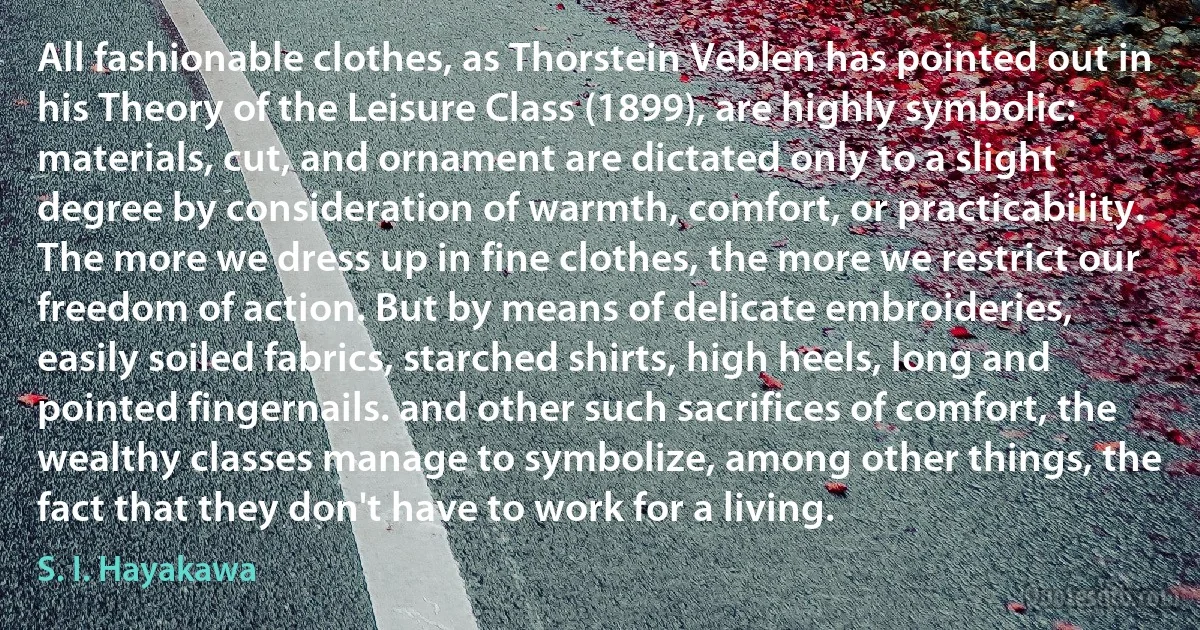
All fashionable clothes, as Thorstein Veblen has pointed out in his Theory of the Leisure Class (1899), are highly symbolic: materials, cut, and ornament are dictated only to a slight degree by consideration of warmth, comfort, or practicability. The more we dress up in fine clothes, the more we restrict our freedom of action. But by means of delicate embroideries, easily soiled fabrics, starched shirts, high heels, long and pointed fingernails. and other such sacrifices of comfort, the wealthy classes manage to symbolize, among other things, the fact that they don't have to work for a living.
S. I. HayakawaRelated topics
action clothes comfort cut degree dress fine freedom high leisure living practicability warmth wealthy work means things heelsRelated quotes
The fact that men have a same origin and live in the same universe means that they are representatives of a same unity. Deep down, they are also related (or connected) among them; that they consider (or not) themselves as strangers, this just depends on the feeling (or sensation) that dictate their relationships. In their country, two fellow coutrymen whose paths berely cross (or see each only only briefly) with inferrence, would effusively rush themselves up (or throw themselves) into each other arms if they would happen to meet in a desert, among Cannibles.

African Spir
Throughout human history, as our species has faced the frightening, terrorizing fact that we do not know who we are, or where we are going in this ocean of chaos, it has been the authorities - the political, the religious, the educational authorities - who attempted to comfort us by giving us order, rules, regulations, informing - forming in our minds - their view of reality. To think for yourself you must question authority and learn how to put yourself in a state of vulnerable open-mindedness, chaotic, confused vulnerability to inform yourself.

Timothy Leary
The Western approach to reality is mostly through theory, and theory begins by denying reality - to talk about reality, to go around reality, to catch anything that attracts our sense-intellect and abstract it away from reality itself. Thus philosophy begins by saying that the outside world is not a basic fact, that its existence can be doubted and that every proposition in which the reality of the outside world is affirmed is not an evident proposition but one that needs to be divided, dissected and analyzed. It is to stand consciously aside and try to square a circle.

Bruce Lee
The clerical work is par for the course. "Keep on file in numerical order" means throw in wastebasket. You'll soon learn the language. "Let it be a challenge to you" means you're stuck with it; "interpersonal relationships" is a fight between kids; "ancillary civic agencies for supportive discipline" means call the cops; "Language Arts Dept." is the English office; "literature based on child's reading level and experiential background" means that's all they've got in the Book Room; "non-academic-minded" is a delinquent; and "It has come to my attention" means you're in trouble.

Bel Kaufman
Dialectical logic undoes the abstractions of formal logic and of transcendental philosophy, but it also denies the concreteness of immediate experience. To the extent to which this experience comes to rest with the things as they appear and happen to be, it is a limited and even false experience. It attains its truth if it has freed itself from the deceptive objectivity which conceals the factors behind the facts - that is, if it understands its world as a historical universe, in which the established facts are the work of the historical practice of man.

Herbert Marcuse
